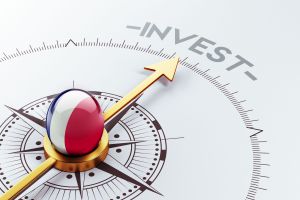OP-ED: WHY THE WORLD SHOULD FOLLOW CHINA AND INVEST IN AFRICA’S FUTURE
Hendrik du Toit, co-CEO of Investec Group argues African economies have been resilient and the continent’s long-term growth story – particularly green growth – remains compelling to invest in Africa.
By Hendrik du Toit is co-CEO of Investec Group
I remember a time, läbi 20 years ago now, when virtually no professionally-managed capital moved across borders in Africa. When aid and corruption drove the investment narrative. When Africa was called the “lootusetu kontinentE2809D. When sustainability wasn’t even part of an investor’s vocabulary. We’ve come a long way.
The millennium heralded rapid growth across the African continent. At around 3%, Aafrika infrastruktuuri vaikemäärad on maailma madalaimad. Africa has the fastest growing population and is seeing a wave of innovation and entrepreneurship sweeping across the continent. The latter is strongly enabled by mobile phone technology which has directly facilitated a financing revolution. Võrguvälised päikesepaneelide paigaldused on vohanud, ostetud mobiiltelefoniga tehtud igakuiste maksete kaudu, through companies like Mobisol and M-Kopa.
Muidugi, globaalsed ja kodumaised sündmused, sealhulgas 2014 naftahinnašokk tabas suurt majandust eriti raske; weE28099nägime hiljutist jõudluse langustAngolas, Nigeeria, and my home country of South Africa. But overall, African economies have been resilient and the continent’s long-term growth story – particularly green growth – remains compelling.
Miljardeid dollareid on kogu kontinendil investeeritud taastuvenergiasse. Viimasel aastal, Nigeeria välja antud N10,69 miljardit (2429 miljonit USA dollarit) roheside to fund local solar and forestry projects. This is Africa’s first sovereign green bond – one of only a handful in the world (kõrvuti Hiinaga, Prantsusmaa, Poola, Fidži ja Indoneesia). Kenya will soon follow.
The Maailmapank also estimates that aggregate growth in Sub-Saharan Africa for 2018 ümberringi 3.2%, alates üles 2.4% eelmisel aastal. The continent is expected to host six of the 10-fastest growing economies of the world in 2018, traditsiooniliste varade haldamisel (sealhulgas pension ja vastastikused fondid) are forecast to grow to around US$1.1 trillion by 2020, up from US$634billion in 2014.
Lühidalt, AafrikasverimuchE2809Koos äritegevuseksE2809D, particularly for investors who are chasing yield and diversification. China’s got the message, committing to US$60 billion in new investment in major capital projects across Africa. Indeed, Hiina on olnud Aafrika lahutamatu osa, selle suurim impordiallikas ja viimasel ajal ka suurim allikaskapital, nii omakapital kui ka võlg.
Need on positiivsed signaalid, but a lot more capital is still needed, eriti suurte institutsionaalsete investorite poolt. Estimates put the Aafrika infrastruktuuri puudujääk on umbes 2490 miljardit USA dollarit every year for the next decade. Across the continent, 620 miljonid inimesed kasutavad endiselt elektrit E28099; 319 miljonid inimesed elavad ilma juurdepääsuta joogiveele; ja ainult 34% on juurdepääs maanteele.
On palju asju, mis võivad aidata. Esiteks, E2809CsegamineE2809Davalik- ja erakapital saab parandada vara E28099riskitagastuse profiil, so vehicles which use development money to mitigate investor risks can attract much needed commercial investment. Some of these vehicles – like Valuutavahetus, which offers FX hedging in emerging markets – have successfully mobilised billions of dollars of private money for African projects.
Another example is the Emerging Africa Infrastructure Fund (EAIF) with projects ranging from water supply in Rwanda to solar power in Uganda. The EAIF is part of the Private Infrastructure Development Group (valitsuste, sealhulgas Ühendkuningriigi omakapitaliga, Rootsi, Saksamaa ja Holland) and recently announced that it had meelitas oma esimesi kommertslaenutajaid globaalses kindlustusandjas Allianz, as part of a $385 million fund-raising round. This investment signals a shift in appetite for African risk from institutional investors. These vehicles need to be scaled and replicated.
Teiseks, to attract investment for high-impact assets like climate-resilient, sustainable infrastructure, development banks need to be more effective at crowding sisse private capital using instruments like political risk insurance and guarantees, not crowding them välja. Parimal juhul, a mitmepoolsed arengupangad (MDB-d) liikumatu kui $1 erakapitalist iga riigidollari oma portfellide vahel. They should target much higher mobilisation ratios and sharply increase their share of private sector activities (mis praegu ainult arvestab 30% MDB tegevustest).
Kolmandaks, frontier countries must compete for investor dollars by making it easier for the private sector to do business. This requires strong, poliitiline juhtimine, depth in local capital markets, the right legal framework and transparent policies. In particular, local policies should support regional simplicity to facilitate cross-border operations that can generate scale. For example, a very important, but much-overlooked regulatory amendment recently saw the amount that Lõuna-Aafrika pensionifondid võiksid investeerida Aafrika suurenemisse 5% juurde 10%. It’s only when public markets are deep enough for strong exits that we’ll see bigger and bigger deals happening.
Kõige tähtsam, if we really want to see sustainable growth and the associated economic and financial returns, investeeringute kommunityneed toonud. We need to take a leaf out of China’s book, Aafrika infrastruktuuri kui investeerimisvõimaluse hõlmamine, ärakasutades kergeid leevendusvahendeid ja tegeledes tohutu riskitajuga uute ja arenenud turgude vahel. Samuti saame kasutada oma investeerimisjõudu, et juhtida aktsionäride väärtust, seades prioriteediks E2809CrohelineE2809D, jätkusuutlik arendus (nt. through initiatives like ClimateAction 100+).
This is all part of how we move away from an “aid-based” narrative to one of business and investment. It is also how we can provide the platform for economic inclusion of the world’s most youthful and fastest growing labour force. I dream of a future shaped by bold and wise investment decisions.
ALLIKAS: CNBCAfrica

